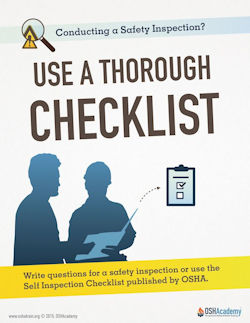The Safety Inspection's Flaw
By its very nature, the walk-around inspection, as a process, suffers from a very serious flaw.
Sole reliance on safety inspections is less effective in identifying unsafe behaviors because inspectors usually spend more time on identifying hazardous conditions.
Because the inspection focuses on identifying hazardous conditions, it may only uncover a small percentage of the surface causes for workplace accidents. It's possible to inspect a workplace one day and have a fatal accident the next day because an unsafe work behavior was missed during the inspection.
Inspection Checklists
To reduce the chance of missing hazards and behaviors, develop checklists with standard questions.
Steps to develop an inspection checklist:
- Determine the area to be inspected.
- Ask workers in the area what tasks/jobs they do.
- Ask them to send you a copy of applicable rules.
- When you receive the rules (don't panic) read through the applicable sections and mark those rules that you feel might result in serious injury if violated.
- Change each marked rule into a simple question. Questions will start with the words: Do, does, is, are.
- Construct your checklist using the questions you have developed.
- Show your boss. He or she will be surprised! (You will probably become a safety director!)
You may use this Self-inspection Checklist as a reference. (Source: OSHA)
Knowledge Check Choose the best answer for the question.
5-5. Why is sole reliance on the safety inspection process ineffective in uncovering the causes for most accidents?
You forgot to answer the question!

